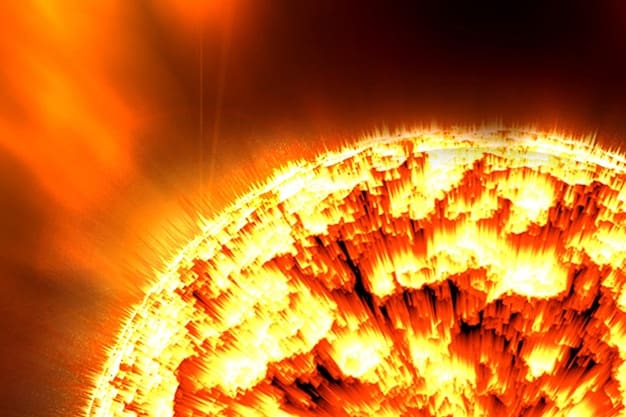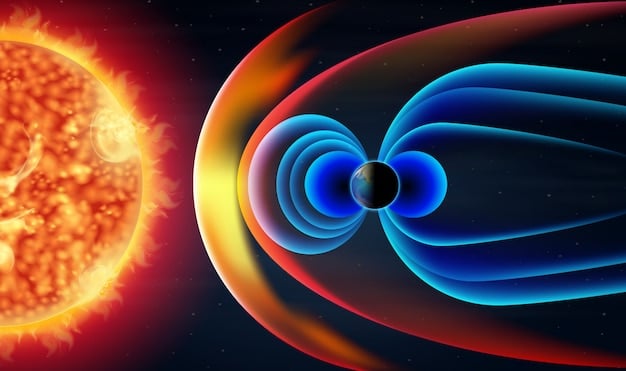2025 Solar Flare Forecast: Prepare for Potential Disruptions

The 2025 solar flare forecast suggests an increase in solar activity, potentially leading to disruptions in communication systems, power grids, and satellite operations; preparing for these potential disruptions is crucial for individuals, organizations, and governments.
Are you ready for the potential impacts of the upcoming solar maximum? The 2025 solar flare forecast predicts a period of heightened solar activity, and it’s crucial to understand how this might affect our daily lives and critical infrastructure.
Understanding the Solar Flare Forecast for 2025
The sun, our nearest star, undergoes cycles of activity, with periods of high activity known as solar maximums and periods of low activity known as solar minimums. The 2025 solar flare forecast indicates that we are approaching a solar maximum, which means an increased frequency and intensity of solar flares.
Solar flares are sudden releases of energy from the sun’s surface, and they can have a significant impact on Earth. These flares emit electromagnetic radiation across all wavelengths, which can interfere with our technology and even pose risks to our health.

What Causes Solar Flares?
Solar flares are caused by the sudden release of magnetic energy stored in the sun’s atmosphere. This energy is built up over time as a result of the sun’s differential rotation, where the equator rotates faster than the poles. This differential rotation causes the magnetic field lines to become twisted and tangled, and eventually, they can snap, releasing a tremendous amount of energy.
Predicting Solar Flares: A Complex Science
Predicting solar flares is a complex scientific endeavor. Scientists use a variety of instruments to monitor the sun’s activity, including telescopes that observe the sun in different wavelengths of light. These observations help them identify regions of the sun that are likely to produce flares.
- Sunspot Activity: Tracking the number and complexity of sunspots can provide clues about potential flare activity.
- Magnetic Field Monitoring: Observing changes in the sun’s magnetic field helps scientists understand where energy is building up.
- Historical Data Analysis: Analyzing past solar cycles helps predict the intensity and frequency of future flares.
Understanding the solar flare forecast is crucial for preparing for potential disruptions. The intensity and frequency of solar flares can impact various aspects of our lives, from communication systems to power grids.
In summary, the 2025 solar flare forecast suggests an increase in solar activity, which could lead to technological disruptions and other impacts. By understanding the causes and predictions of solar flares, we can better prepare for these events.
Potential Impacts of Solar Flares on Earth
Solar flares can have a wide range of impacts on Earth, affecting everything from our communication systems to our health. The 2025 solar flare forecast highlights the need to understand and mitigate these potential disruptions.
One of the most significant impacts of solar flares is their effect on communication systems. The electromagnetic radiation emitted by flares can interfere with radio waves, disrupting communication networks and satellite operations.
Communication Disruptions
Solar flares can disrupt high-frequency (HF) radio communications, which are used by aircraft, ships, and amateur radio operators. These disruptions can last for several hours, making it difficult to communicate over long distances.
Satellite Interference
Solar flares can also interfere with satellite operations. The increased radiation can damage satellite electronics, causing malfunctions or even complete failure. This can disrupt services such as GPS, television broadcasting, and weather forecasting.
- GPS Inaccuracy: Solar flares can affect the accuracy of GPS signals, leading to navigation errors.
- Communication Blackouts: Satellites used for communication can experience temporary blackouts due to interference.
- Data Loss: Satellites may lose data due to radiation damage, affecting various scientific and commercial applications.
Power Grid Vulnerabilities
Power grids are also vulnerable to the effects of solar flares. The geomagnetic disturbances caused by flares can induce currents in long transmission lines, leading to voltage fluctuations and potentially causing transformers to overheat and fail.
It’s important to recognize that while solar flares can cause disruptions, measures can be taken to mitigate these effects. By understanding the potential impacts and implementing protective strategies, we can reduce our vulnerability to solar activity.
In conclusion, solar flares pose a variety of risks to our technology and infrastructure, including communication disruptions, satellite interference, and power grid vulnerabilities. The 2025 solar flare forecast underscores the importance of preparing for these potential impacts to minimize their effects.
Protecting Electronic Devices During a Solar Flare
While we cannot prevent solar flares, we can take steps to protect our electronic devices from the potential damage they can cause. The 2025 solar flare forecast serves as a reminder to implement these protective measures.
One of the simplest ways to protect your electronic devices is to unplug them during a solar flare. This prevents them from being damaged by power surges caused by geomagnetic disturbances.

Unplugging Devices
Unplugging your electronic devices, such as computers, televisions, and appliances, can prevent them from being damaged by power surges. It’s also a good idea to unplug sensitive equipment like medical devices and security systems.
Using Surge Protectors
Surge protectors can help protect your electronic devices from power surges. These devices divert excess voltage away from your equipment, preventing damage. However, it’s important to note that surge protectors may not be effective against the strongest solar flare induced surges.
Investing in a UPS (Uninterruptible Power Supply) can provide backup power and protect against surges. This can be especially important for critical equipment like computers and medical devices.
- Whole-House Surge Protectors: These protect all the devices in your home from power surges.
- Battery Backup: A UPS provides temporary power during outages, allowing you to safely shut down equipment.
- Regular Inspection: Check surge protectors regularly to ensure they are functioning properly.
Faraday Cages
A Faraday cage is an enclosure that blocks electromagnetic fields. Placing electronic devices inside a Faraday cage can protect them from the electromagnetic radiation emitted by solar flares. A simple Faraday cage can be made by wrapping devices in aluminum foil.
Implementing these protective measures can significantly reduce the risk of damage to your electronic devices during a solar flare. By taking these precautions, you can ensure that your equipment remains functional and safe.
In summary, protecting electronic devices during a solar flare involves unplugging devices, using surge protectors, and considering Faraday cages. The 2025 solar flare forecast highlights the need for these precautions to safeguard our valuable electronics.
Preparing Your Home and Family for Solar Flare Events
Preparing your home and family for solar flare events is essential to ensure safety and minimize disruptions. The 2025 solar flare forecast underscores the importance of having a plan in place.
One of the first steps in preparing your home and family is to create an emergency plan. This plan should include steps to take before, during, and after a solar flare event.
Emergency Preparedness Kit
An emergency preparedness kit should include essential supplies such as food, water, medication, and a first-aid kit. It should also include a battery-powered radio to stay informed about the situation.
Communication Plan
A communication plan should outline how you will communicate with family members in the event of a disruption to communication systems. This may involve establishing a meeting place or using alternative communication methods such as walkie-talkies.
Backup Power Sources
Consider investing in backup power sources such as generators or solar panels with battery storage. These can provide electricity during power outages caused by solar flares.
- Generators: Provide temporary power but require fuel and maintenance.
- Solar Panels with Battery Storage: Offer a renewable energy source and can provide power during outages.
- Portable Power Stations: Convenient for charging small devices and can be easily moved.
Stay Informed
Staying informed about the solar flare forecast and potential impacts is crucial. Monitor reliable sources such as the NOAA Space Weather Prediction Center for updates and warnings.
By taking these preparatory steps, you can significantly enhance your family’s safety and resilience during solar flare events. Having a well-thought-out plan and the necessary supplies can make a significant difference in managing the disruptions caused by solar activity.
In conclusion, preparing your home and family for solar flare events involves creating an emergency plan, assembling a preparedness kit, establishing a communication strategy, and staying informed. The 2025 solar flare forecast highlights the importance of these measures for ensuring safety and minimizing disruptions.
The Role of Governments and Organizations in Solar Flare Preparedness
Governments and organizations play a critical role in preparing for and responding to solar flare events. The 2025 solar flare forecast emphasizes the need for coordinated efforts at all levels.
Government agencies such as NOAA’s Space Weather Prediction Center are responsible for monitoring solar activity and issuing warnings about potential impacts. These warnings are crucial for informing the public and enabling organizations to take protective measures.
Infrastructure Protection
Governments and organizations should invest in protecting critical infrastructure such as power grids, communication networks, and satellite systems. This may involve implementing measures to harden these systems against the effects of solar flares.
Public Education
Public education is essential for raising awareness about the potential impacts of solar flares and encouraging individuals to take steps to protect themselves and their property. This may involve disseminating information through various channels such as websites, social media, and public service announcements.
- Emergency Response Exercises: Conduct drills to test preparedness and response plans.
- International Cooperation: Collaborate with other nations to share data and coordinate response efforts.
- Research and Development: Invest in research to improve forecasting capabilities and develop new protective technologies.
Regulatory Frameworks
Governments should establish regulatory frameworks to ensure that organizations are taking appropriate measures to protect critical infrastructure and communication systems. This may involve setting standards for hardening equipment and developing emergency response plans.
By working collaboratively, governments and organizations can significantly enhance our ability to prepare for and respond to solar flare events. These coordinated efforts are crucial for minimizing disruptions and protecting public safety.
In summary, the role of governments and organizations in solar flare preparedness includes monitoring solar activity, protecting critical infrastructure, promoting public education, and establishing regulatory frameworks. The 2025 solar flare forecast underscores the importance of these efforts for ensuring resilience and minimizing the impact of solar flares.
Future Technologies for Predicting and Mitigating Solar Flare Impacts
Advancements in technology are continually improving our ability to predict and mitigate the impacts of solar flares. The 2025 solar flare forecast is driving further innovation in this field.
One of the most promising areas of development is improved forecasting models. Scientists are working to develop more accurate and reliable models that can predict the timing and intensity of solar flares with greater precision.
Space-Based Observatories
New space-based observatories are being developed to provide more detailed and comprehensive observations of the sun. These observatories will provide valuable data for improving forecasting models and understanding the underlying processes that cause solar flares.
Artificial Intelligence (AI)
Artificial intelligence (AI) is being used to analyze large datasets and identify patterns that can help predict solar flares. AI algorithms can process vast amounts of data from various sources and identify subtle indicators that may precede a flare event.
- Data Analysis: AI can analyze complex datasets to improve forecast accuracy.
- Real-Time Monitoring: AI algorithms can monitor solar activity in real-time to detect potential threats.
- Predictive Modeling: AI can develop predictive models to forecast the timing and intensity of solar flares.
Advanced Protection Technologies
Advanced protection technologies are being developed to shield critical infrastructure and communication systems from the effects of solar flares. These technologies include advanced surge protectors, Faraday cages, and hardened electronics.
By investing in these future technologies, we can significantly enhance our ability to prepare for and mitigate the impacts of solar flares. These advancements are crucial for protecting our technology and infrastructure in an increasingly interconnected world.
In conclusion, future technologies for predicting and mitigating solar flare impacts include improved forecasting models, space-based observatories, artificial intelligence, and advanced protection technologies. The 2025 solar flare forecast is a catalyst for ongoing innovation in this critical area.
| Key Point | Brief Description |
|---|---|
| ⚠️ Solar Flare Impact | Disrupts communication, damages satellites, and affects power grids. |
| 🛡️ Electronic Protection | Unplug devices and use surge protectors to prevent damage. |
| 🏠 Home Preparedness | Create an emergency kit and communication plan for your family. |
| 📡 Government Role | Monitoring solar activity, infrastructure protection, and public education. |
FAQ Section
The 2025 solar flare forecast predicts a period of increased solar activity, indicating a higher frequency and intensity of solar flares as we approach the solar maximum. This requires increased vigilance and preparation.
Solar flares emit electromagnetic radiation that can disrupt radio waves, interfering with communication networks and satellite operations. This can lead to temporary blackouts and inaccuracies in GPS signals.
To protect your electronic devices, unplug them during a solar flare, use surge protectors, and consider using Faraday cages. These measures can prevent damage from power surges and electromagnetic radiation.
An emergency preparedness kit should include essential supplies such as food, water, medication, a first-aid kit, and a battery-powered radio. This helps ensure you have basic necessities during disruptions caused by solar flares.
Governments monitor solar activity, protect critical infrastructure, promote public education, and establish regulatory frameworks to ensure organizations take appropriate measures for solar flare preparedness, enhancing overall resilience.
Conclusion
As the 2025 solar flare forecast suggests, increased solar activity is on the horizon. Preparing for potential disruptions is not just a matter of technological readiness but a comprehensive strategy involving individual actions, community preparedness, and governmental oversight. By understanding the risks, implementing protective measures, and staying informed, we can mitigate the impacts of solar flares and ensure a more resilient future.





